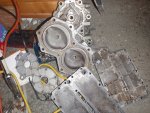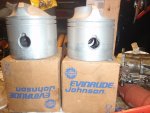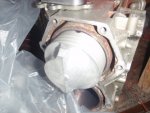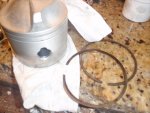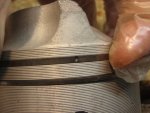Re: opinions on what to do about scratches inside piston wall
Dude... I think you need to stop, and take note for a second. NEVER, EVER SHOULD you re-use a piston ring. Even if you plan on using the ring on the same EXACT piston that the motor had in it. They need to be new to seat properly in the cylinder bore, and to ensure that micro stress cracks don't give way on a newly rebuilt motor and ruin it. Not to mention just putting used rings on a new piston. Junkyard mechanics do shady stuff like this to sell motors. It is wrong on so many levels. Next, do not mix cast and forged pistons in the same block. They expand at different rates, and will probably not weigh the same. This will end badly if you do. You need to get a manual and read it thoroughly... Please. Or I can see the title of you new thread, "Freshly rebuilt powerhead messed up. Why?" Here is a little info On pistons, Maybe it will help you to understand:
Piston Basics
The piston is under-appreciated, for sure. It may be the hardest-working part in the internal combustion engine. Following is just a brief outline of the piston's function and construction.
Three Jobs
The piston does three important jobs. It is a bearing, receiving loads from combustion and transferring them straight and true through the connecting rod to the crankshaft. The piston is also a seal, as it seals combustion's forces and compression's trapped air. Finally, the piston is a heat conductor, transferring some of the cylinder's heat to the outside. In fact, nearly 80 percent of the cylinder's excess heat is drawn away by just the piston's rings.
Piston Parts
The piston is made of essentially seven parts. The piston's top or crown takes the brunt of combustion's forces and heat. Consequently, the crown is the hottest part of the engine after the spark plug. It must therefore be quite thick so as to not collapse, though it is not always the thickest part of the piston. Moving down the piston, the next thing is the ring groove. The closely manufactured groove accepts the third part, the precisely made piston ring. In the four-stroke engine, natural harmonics cause the ring to rotate as the piston goes up and down in the cylinder. This helps the groove stay clean of carbon. The solid pieces between the grooves are called ring lands. They are similar to the lands in a gun barrel. They support the shock loads the rings receive during combustion. The next part is the piston pin hole. This hole accepts a pin that connects the piston to the connecting rod. The hole is offset from the piston's center slightly so that when the piston and rod reach TDC, they do so at slightly different times. This spreads the shock loads at high rpm, easing stresses on the connecting rod and eliminating a noise called "piston slap." Surrounding the hole inside the piston are pin bosses, thick masses of metal that support the pin when it is inserted in the hole. The pin bosses are sometimes the thickest part of the piston. In some cases, they are not as thick as the crown. In either case however, the thickness of these two parts is important, as it determines much about how the piston deals with heat. Lastly, we come to the piston skirt. The skirt is the bearing portion of the piston. It slides against the cylinder wall, bearing the force of combustion on the power stroke, and the loads of compression on the compression stroke. There are also stresses involved with rpm that the piston and cylinder are designed together to deal with. The skirt is the part of the piston most in need of lubrication. Thus most lubrication problems show up on the piston skirt first.
Piston Shapes
There are two important ways in which pistons are shaped. First, the piston is not round, but elliptical in shape. The reason is the fore-mentioned pin bosses. The bosses' mass makes them absorb a lot of heat, which makes them expand more than any part of the piston. If the piston was instead made round, it would not be when fully warmed up. That would be a problem. Therefore, the width of the piston at the area of the bosses is narrower than it is elsewhere. The resulting shape (looking downward onto the piston crown) is an ellipse (an oval). Marine pistons are sometimes called "cam ground," which refers to the same thing (however, it isn't the shape that is being referred to in that case, but rather the machine that produces it). The other (second) shape all pistons have is taper. That is, the diameter of the piston at its crown is considerably smaller than its diameter at the skirt. The reason is the same as for the piston's ellipse. Only this time it is the crown, not the pin bosses, that necessitates the shape. The crown absorbs so much heat that it must be made smaller so that when fully heated, the piston will be straight.
Piston Manufacturing Methods
Pistons are manufactured in one of two ways. Those two ways are the cast piston and the forged piston. This brings us back to our question, which is better, cast or forged? But not so quickly. The cast piston is made of molten aluminum. The alloy is flowed into a mold having the shape of the finished product, in much the same way that many other cast parts are made. However, don't imagine wooden boxes full of coarse sand, into which melted aluminum is poured. Piston molds are actually permanent dies, intricately made multiple-piece steel shapes. The molten aluminum is vacuum drawn into the mold. So accurate is the process that the resulting casting requires minimal machining. The forged piston is made very differently. The metal is not molten, but heated somewhat. A blob of this hot aluminum alloy called an ingot is placed in a female mold, and a male ram is pounded into it. The result is not a piston, but a piston blank, which must then undergo many machining operations before it resembles a piston. These two methods of making pistons continue today, and there are interesting reasons for each of them. Let's examine those reasons by looking at the history and applications of each piston type.
The Cast Piston
The cast aluminum alloy piston has perhaps the longer history. It took over for the original steel part during the internal combustion engine's early development. The cast piston is the most familiar piston type.
Casting Alloys
Early cast aluminum pistons were made with inferior alloys. The piston expanded dramatically, requiring a loose fit in the cylinder and resulting in noisy operation when cold. Harley-Davidson pistons once had steel ribs inside them to control this expansion. Since about the 1960s however, most cast pistons have been un-strutted. Their alloys have gained silicon, a material that gives the pistons natural lubricity and limits heat expansion. All modern pistons have silicon in them. However, cast pistons have historically had the most. Some of them have as much as 25 percent silicon by volume. Silicon does bring a disadvantage however. It makes the piston brittle. Dropping a modern cast piston will usually crack it, so the piston must be handled carefully.
Mass Efficiency
Probably the greatest benefit of the cast piston is the efficiency of its mass. The multiple-piece molds allow intricate contours inside and out, resulting in light weight, good expansion control, and predictable heat flow through the part. That is, the piston designer can plan in the specific thickness in each place in the part that is desired, to result in expansion at those places that is warranted. So predictable is the cast piston's heat in fact that race tuners view the undersides of the piston to gauge the combustion efficiency of the engine. In much the same way others read spark plug, they read the dark splotches under the crown.
Applications
The cast piston is however expensive to manufacture. Die casting is costly, because it requires huge machines that do very specific jobs, and can't be easily adapted to do more than one kind of job. The result is that the casting process for pistons is relegated to the large piston supplier. The downside is that the cast piston is often found only in OEM specified sizes and types. There aren't a lot of different cast pistons to chose from if you are modifying an engine. The upside of this situation is that since only large piston manufacturers can afford to make cast pistons, they are usually competently made. In fact, the cast piston generally typifies the best technology that the piston industry has to offer. However, this doesn't mean it's the best piston for every application.
The Forged Piston
The forged piston is a more recent development. It appeared first on high-powered two-stroke engines. These engines were made in low production numbers, and their performance and use resulted in frequent detonation. Both of these traits, as we'll see, made the forged piston a pretty good match for this application.
Forging Alloys
The earliest forged pistons were also made with poor alloys. In many cases however they were even worse than the alloys the cast pistons used, because when the cast piston finally got silicon, the forged piston did not. The same brittleness that makes the cast piston crack when bumped hard would have resulted in even larger defects had it been used in a forging. Consequently, during the time that the cast piston defined a piston's normal expansion rate, the forged piston was far behind the technology. The forged piston had to be fitted loose, which made it noisy and wasted power. Recently however, silicon has been introduced to the forged piston. A mixture of alloys has been found that together with silicon do not result in defective forgings. For example, nickel has been found to offset the silicon's tendency toward brittleness. However, not very much nickel can be used, as it is a heavy metal, and it affects the mixture in other ways. The result is that the modern forged piston is much more dimensionally stable than was true in the past.
Mass Efficiency
However, once again, the forged piston's mass does more to define its characteristics than does even its materials. The forged piston has historically had a crude interior shape. The forging ram is straight, which results in a rectangular rather than an intricate interior. There is too much mass there. Consequently, the forged piston has poor dimensional stability. Its expansion is not very controllable. Many engine builders overcome these two problems (too much weight, unpredictable expansion) at least partly by removing by hand the extra material inside the forged piston. This allows them to fit them tighter and rev them higher. However, many forged pistons also have overly thick skirts as well as unsophisticated interiors. This is because the forging produces a piston blank, remember, and not a finished piston. The piston wholesaler takes this blank, and from it, carves out several different sizes and shapes of pistons. If the piston being made happens to be the largest the blank supports, it ends up with the thickest skirt. While hand reworking (or CNC milling, as many do now) the forged piston can lighten it and make it behave more like an intricately made cast piston, there is still excess weight due to the thick skirt.
Applications
Unlike the cast piston, the forged piston is easy to manufacture. Smaller piston manufacturers therefore specialize in this piston type, even if some of them may not be as competent at making pistons as are the larger cast piston makers. Forged pistons have quickly become the choice of custom engine builders because they can be had very quickly, and in virtually any configuration desired. Moreover, the forged piston's added thickness is used by these builders to custom configure the piston even further. For example, flycuts on the piston's crown for high performance valve relief is an easy process with the forged piston. There's a lot of material there in which to do it, much more than there is in the cast piston. The forged piston was also the first piston type to adopt the modern ultra-thin piston ring, for the same reason. It could be done easily and immediately. There were no molds for such a piston among the cast piston manufacturers for at least a year afterward. This situation has resulted in the forged piston acquiring something of a high performance personna, even though its overall technology is less current than the cast piston's. Most of that reputation is unearned, but in at least one way it is in fact a reality. The forged piston is inherently stronger than the cast piston. Lower silicon content of course would result in this, making the forged piston less brittle. However, there is another reason as well. The forging process compresses the alloy's molecules, making the material more dense than a casting. The result is a piston that withstands the pounding of detonation better. This is why OEMs use the forged piston in two-strokes and turbocharged engines. Forged pistons are also included in many OEM high performance options kits for their street models.
Summary
To sum up, the cast piston is light and very dimensionally stable. It is found in high-rpm mass-produced engines that are not subject to modification or prone to detonation. The piston is however fairly brittle, and the cost of its manufacture has limited its availability outside the OEM sources and applications. On the other hand, the forged piston is inherently heavy and less dimensionally stable. It is a good choice for engines in which detonation is probable, and its wide availability has made it the choice of engine modifiers. The special demands of these end users has given the forged piston its own niche in the powersports market. The next time someone tells you how superior one piston type is over another, tell them the truth. Because, as Paul Harvey likes to say, "Now you know the rest of the story." Hold the fries, please.




















